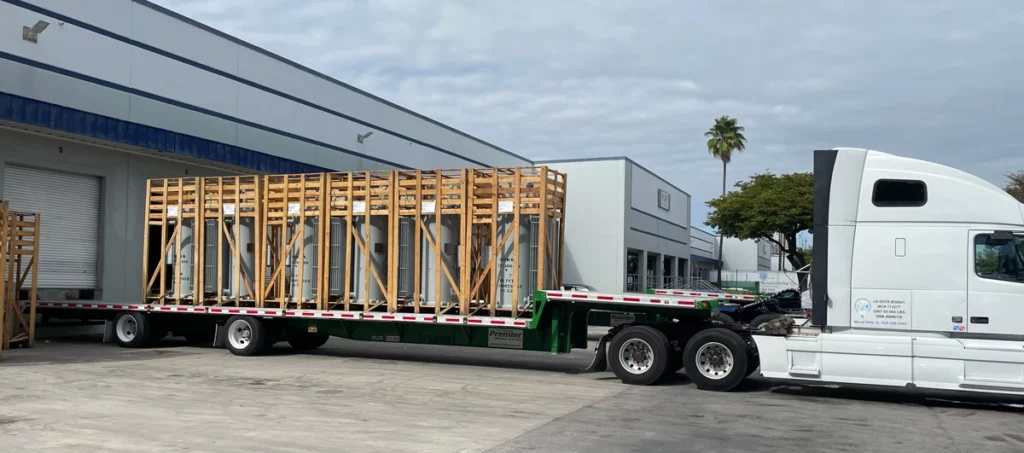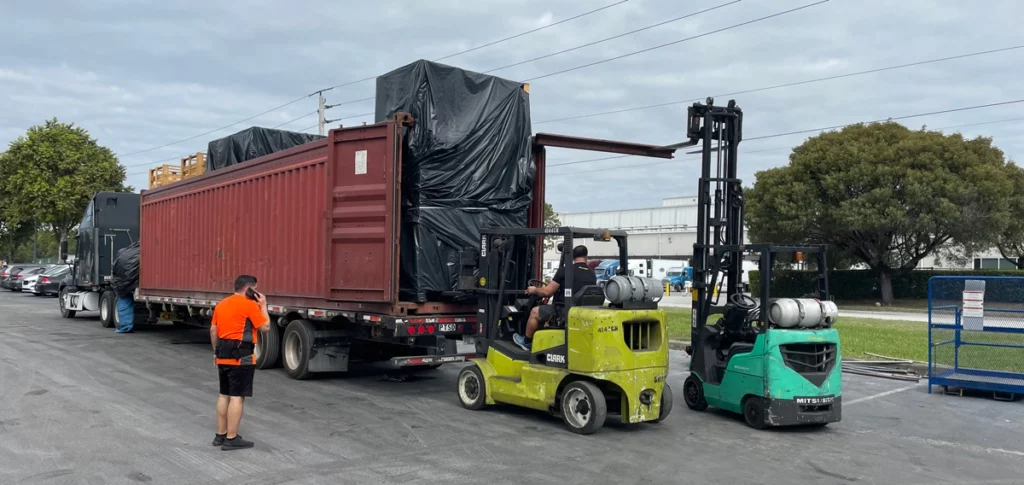Maximizing Efficiency: Flatbed Load Optimization in Logistics

How Strategic Loading Practices Improve Safety, Cost, and Delivery Speed
In today’s dynamic supply chain environment, logistics providers face increasing pressure to deliver goods faster, safer, and at lower costs. Flatbed shipping plays a key role in meeting these demands, offering the versatility needed to transport oversized, heavy, or oddly shaped cargo that standard enclosed trailers simply can’t accommodate. However, the flexibility of flatbed shipping also introduces a unique set of challenges, particularly when it comes to load optimization.
At PTS Logistics, our Miami Warehouse is at the forefront of flatbed logistics, providing tailored solutions to meet the growing and increasingly complex demands of shippers. Through smart planning, advanced technology, and a deep understanding of industry regulations, we help clients achieve greater efficiency and performance from their flatbed operations.
This blog explores the critical components of flatbed load optimization, the strategies top logistics providers use, and how embracing technology is transforming the industry for the better.
The Importance of Flatbed Load Optimization
Flatbed trailers are essential for transporting large or irregular freight that cannot fit in a standard dry van. Think construction materials, heavy machinery, steel coils, or modular structures. Because flatbeds are open and accessible from all sides, they offer unique loading and unloading advantages—but they also require precise planning to ensure stability, safety, and compliance.
Optimizing how cargo is loaded onto a flatbed affects nearly every aspect of the delivery process:
- Fuel efficiency: Balanced and secure loads reduce wind drag and improve aerodynamics, contributing to better fuel economy.
- Driver safety: Proper load placement minimizes the risk of shifting freight and improves vehicle handling.
- Regulatory compliance: DOT and state-level axle weight restrictions must be met to avoid costly fines or delays.
- Delivery times: Efficient loading leads to smoother transport, fewer disruptions, and more predictable timelines.
Common Challenges in Flatbed Logistics
While flatbed shipping offers clear advantages, it also comes with significant planning requirements. These challenges can quickly impact timelines and budgets if not managed effectively:
- Weight distribution: Cargo must be evenly distributed across axles to avoid exceeding legal limits.
- Securing irregular loads: Some freight requires specialized tie-downs, tarps, or bracing to ensure safe transport.
- Variable weather conditions: With no enclosure, freight is exposed to the elements and must be protected accordingly.
- Route planning: Height and weight restrictions can vary dramatically by state or region, affecting the optimal route.

Strategies for Effective Flatbed Load Optimization
At PTS Logistics, we employ a combination of strategic practices and industry best standards to ensure our flatbed shipments are optimized for performance and compliance.
1. Smart Stacking and Load Configuration
Layering and angling freight to minimize empty space is one of the most effective ways to optimize a flatbed load. This technique, often referred to as smart stacking, involves placing compatible freight items in a way that maximizes trailer space without compromising cargo safety.
For example, pipes or steel rods might be stacked in cradles to maintain stability, while pallets of building materials can be layered in staggered configurations to minimize shifting during transit. Proper use of dunnage (filler materials) and edge protectors also helps maintain load integrity while maximizing usable space.
2. Axle Weight Balancing
Weight distribution plays a critical role in the performance and legality of any flatbed shipment. Overloading a single axle can result in DOT violations, damage to equipment, or unsafe driving conditions. That’s why our team conducts detailed weight analyses before loading begins.
Using weight distribution models and trailer-specific guidelines, we strategically position cargo to balance loads evenly across the tractor and trailer axles. This not only keeps shipments compliant but also improves driver control and reduces maintenance wear and tear.
3. Route-Aware Load Planning
Flatbed loads must often travel across multiple jurisdictions with varying road laws. Bridge weight limits, low clearance bridges, and route-specific restrictions can create major disruptions if not accounted for in advance. At PTS Logistics, we take a route-aware approach to load planning.
This means designing the load layout based on the physical demands of the delivery route. For instance, if a route involves steep grades or winding roads, the load may need to be configured with a lower center of gravity to enhance stability. Likewise, tall cargo may require alternate routing to avoid overhead obstacles.
4. Advanced Load Securing Techniques
Securement is a top priority in flatbed logistics. Inadequately secured cargo is a danger to the driver, other vehicles, and the freight itself. Our team uses advanced securement techniques, including:
- Chains, straps, and winch binders rated for heavy-duty loads
- Edge protectors to prevent strap damage
- Tarpaulins for weather-sensitive freight
- Customized blocking and bracing
Securement is not one-size-fits-all. We tailor each strategy based on the specific type of cargo, trailer design, and delivery environment.
The Role of Technology in Flatbed Optimization
Technology is rapidly transforming the flatbed logistics sector. By combining logistics expertise with digital tools, providers like PTS Logistics are improving accuracy, reducing costs, and increasing service reliability.
AI-Powered Load Mapping
Artificial intelligence and machine learning tools are now being used to simulate load configurations based on cargo type, weight, size, and shape. These systems generate digital load maps that allow teams to evaluate multiple configurations and select the most efficient one.
This reduces trial-and-error in the yard and ensures compliance before the truck even arrives.
Digital Route Planning Tools
Modern logistics platforms integrate GPS, traffic analytics, and regulatory data to produce optimized delivery routes in real-time. These systems account for:
- Road restrictions
- Weather patterns
- Bridge height and weight limits
- Traffic flow and construction zones
This proactive planning ensures on-time delivery while minimizing fuel use and risk.
Real-Time Load Monitoring
IoT (Internet of Things) sensors and telematics devices enable real-time tracking of load stability, weight distribution, and trailer conditions. Alerts can be triggered if securement fails, a load shifts, or conditions exceed safety thresholds.
These tools enhance safety and allow for rapid intervention, reducing risk to freight and drivers.
The Competitive Advantage of Optimized Flatbed Shipping
In today’s logistics landscape, shippers expect more than basic delivery services. They want partners who can help reduce costs, improve timelines, and mitigate risk. Flatbed optimization provides a clear competitive edge by achieving all three.
Here’s how:
- Lower Fuel Costs: Balanced and well-configured loads reduce fuel consumption.
- Faster Turnaround: Streamlined loading and routing reduces delays.
- Greater Reliability: Secure, compliant loads minimize disruptions.
- Improved Safety: Optimized loads enhance handling and reduce accident risk.
At PTS Logistics, our Miami Warehouse is designed to support this level of performance. With experienced personnel, state-of-the-art equipment, and smart logistics tools, we provide end-to-end flatbed solutions that give our clients a distinct advantage.
Final Thoughts
Flatbed shipping may be complex, but with the right approach, it becomes a powerful tool for logistics success. From detailed load planning to intelligent technology integration, PTS Logistics is committed to helping our clients move their freight safely, efficiently, and cost-effectively.
If you’re looking to improve the way you manage flatbed transportation, our Miami-based logistics team is ready to help. Contact us today to learn how our optimized flatbed solutions can elevate your supply chain performance.
